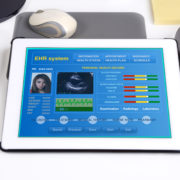What Are The Basic Features Of A Quality EHR System?
Whether you’re just starting out or upgrading your current electronic health records (EHR) system, the process of finding the right software to get the job done can seem like a daunting task. What should you look for? What basic features do you need to keep your practice running smoothly? How can you use advanced features to get the most out of your orthopedic practice and get the best results for your patients? Here’s a quick guide to help you get up and running, featuring the minimum requirements from the Institute of Medicine
What are the basic features of a quality EHR system?
- Health records and data: The core of any EHR system is health records. You’ll need to securely store clinical information for patients and any data recorded in an electronic format. The information also needs to be quickly retrievable, potentially with other health practices in your area.
- Management of test results: When you send a patient out to have additional testing done to help with diagnoses or management of symptoms, the ability to manage those test results is a vital part to providing exceptional care for your patients.
- Managing orders and prescriptions: Quickly sending new prescriptions or authorize refills from within the EHR system allows you to both ensure that the patient is getting the medication they need as well as tracking it directly within the system. This makes it much faster for patients to get the medications they need.
- Support for medical decisions or choices: When you’re making tough decisions for patients, it’s important to document those decisions, including potential issues that may arise down the road. It also provides you with a way to alert practice healthcare workers to potential interactions or issues before problems occur.
- Electronic communication: Being able to quickly receive or send records to another provider makes it much easier to get patients seen quickly, speeding up their treatment time and making sure they can have the best possible recovery from their ailments. A highly connected system can make this process almost instantaneous.
- Patient information and support: Patients who don’t follow their care instructions can see serious problems with their health or slower recovery times. By having that information freely available through a secure login, you can make sure they can check those instructions or ask questions after the initial appointment.
- Administrative processes: What could you do with your practice if paperwork was cut down to a minimum while still ensuring quality outcomes? Digitizing your practice management allows you to drastically reduce the amount of manual input required for billing, scheduling and similar administrative tasks and reporting.
- Population health reports: Has there been a serious spike in a particular type of injury or illness in your area, or is it just your imagination? Whether it’s tracking outcomes from surgical procedures or new physical therapy techniques, this aspect of the EHR system allows you to produce reports based on your clinical data.
By knowing the basics of what should be included in a quality EHR system, you can ensure that you’re getting all the features you need for your investment. Then you can take the time to develop a list of minimum requirements that will meet your practice’s needs. Not quite sure what other features can make your practice excel? Exscribe’s suite of highly connected orthopedic solutions can help you get your best results quickly and easily. Please feel free to contact us today to request a demo and see where our EHR system can take your practice today.











